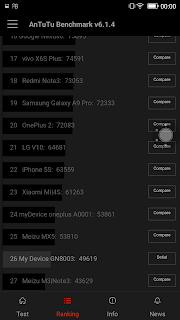Introduction
Smartphone manufacturer Gioneee launched their flagship M6 smartphone at Chinese National Convention Centrea few days ago on the 26th July 2016. The smartphone aims to solve various pain points of business users and truly differentiate itself from competitors in the international market.
Specifications
|
Color
|
Gold and Latte Gold
|
|
Dimensions
|
152.3 x 75.3 x
8.2mm |
|
CPU
|
MT6755 (MediaTek
Helios P10) |
|
Battery
|
Non-removable
Li-ion Battery rated at 5000mAh |
|
SIM
|
Dual Micro SIM with
full band support(in China) |
|
Display
|
·
5.5 inch Full HD AMOLED ·
1920 x 1080, 401PPI ·
NTSC 100% color gamut ·
30000:1 contract ratio |
|
OS
|
Android 6.0 with
Amigo 3.2 |
|
Memory
|
4GB RAM
|
|
Storage
|
64GB
|
|
Storage
Expansion |
MicroSD card slot
with support up to 128GB MicroSD cards |
|
Rear
Camera |
·
13MP ·
Sony IMX258 Sensor ·
Pixel size of 1.12um ·
F2.0 ·
PDAF ·
5P Lens |
|
Front
Camera |
·
8MP ·
OV8856 ·
1.12um pixel size ·
4P lens |
|
Audio
Interface |
·
3.5mm audio jack |
Design
Gionee did not scrimp on the design of creating this premium flagship product for their M series. The M6 is made mainly from metal, giving it a sturdy, yet sexy and classy visuals. In fact, 94% of the smartphone is made from metals.
The Gionee designers have emphasized on small details that allows the device to shine. For example, the sides of the smartphone are precisely cut and then polished, creating a contrast from the main body. Being extremely proud of their brand, Gionee has also placed extra attention on the logo at the back (not to be mistaken as a fingerprint sensor) of the device. The logo smiles extra brightly in gold, bring live to the whole device. Bringing such a premium device to the market really shows the whole how capable the chinese are in designing and manufacturing smartphones. Their craftsmanship is commendable.
Security
A hardware security encryption chip is found internally within the Gionee M6. This chip essentially allows a faster and more secured encryption of data that is transmitted through the network. Data that is stored on the phone can also be encrypted with the “private space” application that is preinstalled. These encrypted files will not be accessible even externally, as the hardware ID of the encryption chip is used as a key for encryption. This makes unauthorized access to files within private space almost impossible.
Hardware and software combines and work together to create various possible applications that are extremely secure. Gionee also have developed multiple secured application for use on the M6. Such applications includes, but are not limited to internet banking verification, online payment, encrypted SMS and phone calls etc.
| Home Button is also a fingerprint sensor |
Additionally, a front fingerprint sensor found on the home button also works together with the encryption chip to provide a more secured working environment for the smartphone.
Camera Quality
In this test, we had the Gionee M6 side by side with a Xiaomi Mi 5 to see the difference between the camera quality of the two smartphones. Both smartphones are in the same price range, therefore can make a good comparison.
Based on the results, it seems that the images produced by both the Mi 5 the M6 looks above average well. Overall, the M6 had brighter images, but failed to capture more details. This could be due to the chipset differences between the two smartphones, as the Mi 5, with the Snapdragon 820 chipset allows additional camera features that improves overall photo and video quality.
It was also found that the M6 struggles to focus and capture photos quickly. The M6 also lacks optical stabilization features that is available on the Mi 5, but has software stabilization features that crops the video and stabilize it at the expense of video quality. It was also noted that the Gionee M6 was only able to record videos in 3gp format.
It must be remembered that the Gionee M6 is targeted at the business users, who may not utilize the camera functions as often. Despite having less desired camera, the Gionee M6 still captures pretty decent photos and videos, which could be sufficient to most businessmen.
Performance Benchmarks
With the limited time that we have on the device, we decided to run AnTuTu and 3DMark Ice Storm Unlimited to determine its computational performance. The one year old MediaTek Helios P10 chipset that is found on the Gionee M6 has been proven to perform well for mainstream users. Its low power consumption makes it ideal for the Gionee M6 which focuses a lot on battery life. Of course, users should not expect through the roof performance on the device. Below are the benchmark results and performance of other devices for comparison.
Despite having rather disappointing benchmark scores for a flagship product, we found that the smartphone remains to be extremely responsive. There weren’t any breakdowns or non-responsive applications. This could be due to Gionee’s additional optimization of the chipset to its operating system thanks to their experience with the chipset. We also understood that Gionee aims to provide solutions to “real needs” for their targeted user group, and therefore, explained to us that they felt that the Helios P10 was already sufficient for business users.
Final Words and Conclusion
|
Pros
|
Cons
|
|
·
Unmatched battery life for a 5.5-inch device ·
Stunning premium design ·
Supports Storage Expansion with MicroSD card slot ·
High Security Features |
·
Rather weak CPU performance for a flagship device ·
Camera quality is not the best |
The Gionee M6 is a exquisitely crafted and well designed smartphone. Its unique design allows it to differentiate itself from the other smartphones out in the market and could be a hit with business users.
| William Lu Weibing, President of Gionee (Left) Arvind Vohra, Country CEO & MD, Gionee India (Right) |
FOLLOW us on our Twitter
LIKE us on our FaceBook
SUBSCRIBE to us on our YouTube Channel!

















